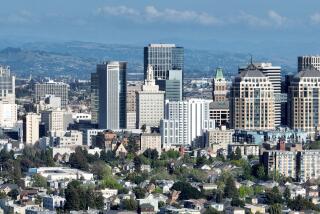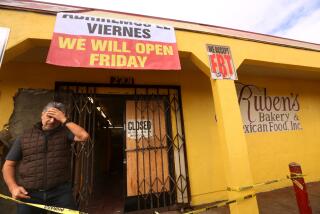AFTER THE RIOTS: THE SEARCH FOR ANSWERS : Burning Issues : Effects: Business owners and frightened residents face a reality after the violence--to stay and rebuild or to leave. Damage from arson and looting in the area will hit at least $17 million.
As National Guard troops give way to insurance adjusters in the wake of last week’s rioting, South Bay residents appear relieved that they weren’t hit harder by the violence yet shaken that such chaos could occur so close to home.
In economic terms, the area finds itself facing at least $17 million in property damage and a potentially serious blow to its business reputation. But the most immediate fallout has been emotional, and for some it has raised one of life’s tougher questions: whether to stay or to leave.
“My parents have been planning to move to Nebraska this summer to retire, and I’m seriously thinking about going with them now that this has happened,” said Angela Cannon of Inglewood, a 32-year-old mother of four.
Gazing at the slumped skeleton of a Manchester Boulevard restaurant gutted by fire, Cannon added: “I don’t want to raise my kids in this atmosphere, even if that means living in the middle of nowhere.”
South Bay cities reported at least two deaths, 34 injuries, 55 fires and 800 arrests in riots that erupted after not guilty verdicts for four white Los Angeles police officers who had been charged in the beating of black motorist Rodney G. King.
The violence was far less extensive than in nearby Compton and South Los Angeles, where disturbances first became violent. But more than three dozen South Bay businesses burned down, and scores more were looted or vandalized.
Experts say that the destruction--no matter where it was heaviest--could unleash damaging repercussions in the local economy. The South Bay must attract new businesses to replace firms that have closed or moved due to defense cuts and recession, they point out. News of the riots, they assert, has made that job much harder.
“On the East Coast and in the Midwest, business people see what happened on the news and lump the Los Angeles area together,” said Leron Gubler, president of the South Bay Assn. of Chambers of Commerce. “That affects everyone in the South Bay because it has a detrimental effect on the perception of this area as a place to live and do business.”
In the South Bay, the violence was limited mainly to Inglewood, Lennox, Lawndale, Hawthorne, Gardena and the northern portion of Carson. Overall, the South Bay accounted for only a fraction of the Los Angeles area’s estimated toll of 58 dead, 2,383 injured, 14,103 arrested and $785 million in property damage.
One of the two local fatalities occurred late April 29, the day the rioting began. Inglewood police said they killed a man who was trying to rob a couple at gunpoint. They said they also wounded a woman, allegedly the robber’s accomplice, and four other people who fired on them at the scene of a looting.
The other death occurred in Lennox on Thursday, when a 15-year-old boy who allegedly was armed and had broken into a jewelry store was shot and killed by sheriff’s deputies after a high-speed chase.
In Wilmington, a mob nearly beat a man to death early Thursday near an apartment complex known for drug dealing. The victim, Jeff Vink, 28, was saved by the driver of a cab in which he had been riding when the attack began.
Despite the bloodshed, officials said the South Bay should feel fortunate. Said Tim King, a commander with the Los Angeles Police Department’s Harbor Division: “We were relatively quiet compared to other regions.”
The bulk of the South Bay’s property damage occurred in Inglewood, where fire--several of them in mini-malls--destroyed 32 businesses valued at an estimated $7.7 million. Although the damage has been attributed to opportunistic hooligans, there were signs that some had the King verdicts in mind.
At one burned-out fast-food restaurant, the words “This is for Rodney” had been spray-painted on the front wall.
Looters hit four major supermarkets in Inglewood but did not burn them. All four markets, swathed in plywood to plug broken windows and doors, reopened for business this week. They drew numerous residents from South Los Angeles whose neighborhood markets had been gutted.
In all, looting boosted Inglewood’s property damage figure to about $10 million, police said. City officials assert that the number would have been higher if the police had not acted quickly to confront rioters.
“We were fighting back, and where we could see them, we were chasing them,” Oliver M. Thompson, Inglewood’s new police chief, said of the looters. “We have officers who will fight back on the street.”
In Hawthorne, about four dozen buildings sustained damage, mostly from looters. Montgomery Ward, the Hawthorne Plaza’s anchor store, lost an undetermined amount of electronic equipment, auto parts, jewelry and clothing, said William Demarest, the mall’s general manager.
Fire gutted only one Hawthorne business--the South Bay Lutheran High School Thrift Shop, a volunteer-operated store that supported a private high school in Inglewood serving 150 students, most of them black. The store lost an estimated $50,000 worth of donated merchandise, including kitchenware, furniture, clothing and a collection of antique books.
“It’s hard to believe someone would do this,” said Hawthorne resident Dorothy Fuller, a frequent donor and customer. “The volunteers who worked here were interracial. They were black, white, and one lady was handicapped. I’m sad about the whole thing, but to do something to a thrift store, that’s the part that hurt me.”
Although the structure’s owner said he has not decided whether he will rebuild, school officials appear determined to reopen the thrift shop, if not at its present location, then somewhere else.
“We’ve had setbacks before, but we’re going to go on,” school Principal Norbert Huber said. “There’s been a feeling of resilience and renewal here that this is such a worthwhile ministry that nothing is going to prevent us from going on.”
In Carson, six buildings were set afire, all of them in the northern part of the city. One, Del’s Liquor Store, has already reopened. Owner Tom Pinkston vowed this week that he will remain in Carson.
“The people are very sympathetic,” he said. “We anticipate doing more business. People know we sucked it up and are going to stay.”
Other business owners were not so optimistic, particularly immigrants who consider much of the rioting a racially motivated attack against them. For instance, Song and Mija Yi, Korean immigrants who own a Hawthorne liquor store that suffered about $50,000 in losses from looting, are looking to leave town.
The couple, who moved here from Korea in 1981, cleaned houses for three years before saving enough money to open their store in 1985. Lately, they had been thinking about selling the business. Their minds were apparently made up for them on Thursday, when about 50 youths broke into the store, carting away the cash register, alcohol, cigarettes and an entire display of panty hose.
“They want to sell this place and go to a safe place,” said their son, Paul Lee, 22. “We can recover this store this week, but the hurting will go on and on.”
An Inglewood ice cream store owner, an immigrant who declined to give his name or say where he was from because he feared for his safety, expressed deep concern about the violence even though his business was left untouched.
The owner of two ice cream stores in the Los Angeles area, he said he could not close his Inglewood site because he has too much invested in it. But the violence persuaded him that when he opens his next one, it will be far from Los Angeles. With economic pressures pinching many of his low-income patrons, he said, he has sensed increasing animosity from across the counter.
“I hear remarks many times like, ‘You guys come in and make all the money and we have nowhere to go,’ ” he said. “If I’m not safe personally, there’s no sense for me to do business. As far as my next store is concerned, L.A. County is out.”
Business leaders say they expect many damaged businesses to rebuild because, like the Inglewood ice cream store, they are small and have too much invested to pull out. The chief concern, they say, is that the South Bay may find it harder to retain high-paying employers, such as high-tech firms, and attract new ones to offset an ongoing drain of manufacturing jobs.
Even before the riots, that task was not easy, Gubler said. He cites Pentagon consideration of a plan to close the Los Angeles Air Force Base in El Segundo and move the base’s highly prized occupant, the Air Force’s Space Systems Division.
Los Angeles-area business leaders have been lobbying hard to keep the space division, which procures military space hardware and is considered a key stimulus to local aerospace business. But Gubler says last week’s violence will complicate matters: “I just talked to the commander of the Air Force base, and he said this couldn’t have come at a worse time.”
Gubler says a major challenge posed by the riots is to confront the socioeconomic problems that helped fuel them. The South Bay, he says, has a big stake in seeing those problems resolved.
“We’ve got to work to see this does not happen again,” Gubler said. “We can’t sweep it under the rug.”
Contributing to this report were Times staff writers Michele Fuetsch, Kim Kowsky, Greg Krikorian and Anthony Millican.
More to Read
Sign up for Essential California
The most important California stories and recommendations in your inbox every morning.
You may occasionally receive promotional content from the Los Angeles Times.









